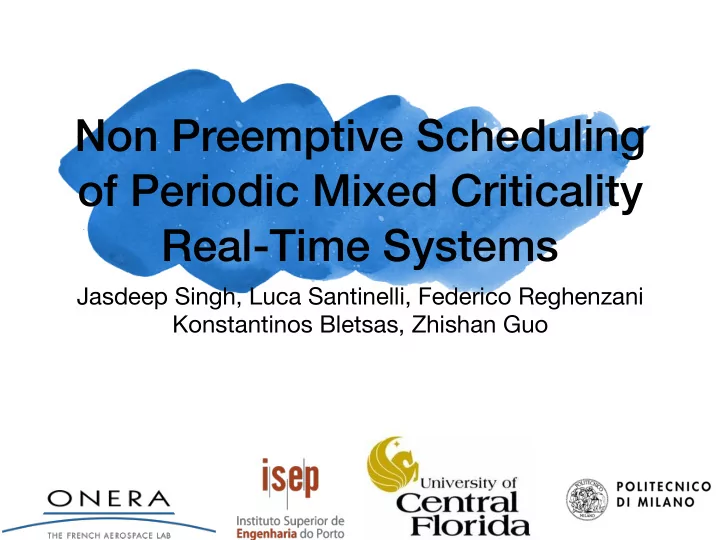

Non Preemptive Scheduling of Periodic Mixed Criticality Real-Time Systems Jasdeep Singh, Luca Santinelli, Federico Reghenzani Konstantinos Bletsas, Zhishan Guo
Outline • Real-time systems • Probabilistic Real-time systems • Mixed criticality systems • Graph and Tree model • Schedule • Worst Case Evaluation
Real-Time applications • System of tasks to be executed on processors with resources • Require real-world timing guarantees • Done through scheduling: Arrange task execution in time • Scheduling uses task WCET • Real execution time is Rarely equal to WCET
Probabilistic R/T systems • Practically, execution time is rarely equal to WCET • Instead of WCET => pWCET (probabilistic worst case execution time) • pWCET: worst case probability distribution of various possible execution times • pWCET is assumed given c i t s i l i b f o a b n o o r i ! P t a T c E fi C i t W n a n u i q m s i m i s s e p
Mixed Criticality Systems • MC Systems: Tasks with di ff erent criticalities • Each criticality corresponds to system criticality • Task takes more time than ‘expected’=> system HI mode • Lower and Upper WCET • System HI mode => All LO tasks are dropped; schedulability of HI ensured c i t s i n i m f r o e t t e n D e m t n s i u • Model represents clear line between processor demands m j d s a i m i s s ! e T p E C W If one HI task takes longer than “usual” MC from PWCET More time to execute System:LO System:HI Tasks:HI Tasks:HI Tasks:HI Tasks:HI Tasks:LO Tasks:LO Tasks:LO Tasks:LO
Graph and Tree Model • Mix of tasks with three level criticality • Each has a probability
The Schedule • Graph -> Tree • Available paths: all jobs • Valid paths: no job misses deadline (evaluate response time) • Dangerous path: no job misses deadline in higher criticalities • Schedule: Optimize (Tree minus non-valid and dangerous paths) • Optimize: Allowing maximum s i e jobs to execute, independent of l u d e n h i c d S job entering high criticality e z ! i m e g i t a p s o u e c r u o s e r
The Schedule • No System-wide mode switch • Ensured that no job misses deadline, in any criticality • Schedule adjusts if job enters high criticality, drops only necessary ones, at lower criticalities, maximum utilization • Schedule is a tree and knows which branch to take at which event • Complexity is reduced by checking for deadline miss while tree construction • Quantify the probability of system entering higher criticalities (we can only quantify)
Evaluation: Response Time • Convolution has hidden assumption: task/jobs arrive at same time • Convolution safe but pessimistic • We propose: e s n o p s e e R h w t s o e N k v s i g a t e f m o i y t t i l i ! b I a H b g o n r p i r e T t E n C e W T O N
Propositions for Mixed Criticality • Response time for MC : System HI mode is a run-time information • Probability and Schedule: Probability comes into play, schedule can depend on the probability • Schedule for optimal Probability : Probability from response time now depends on schedule • Be prepared for worst case : execution scenarios upper bounded, schedule adapts for system entering higher mode; Previous model to upper bound
Thank you !
Recommend
More recommend